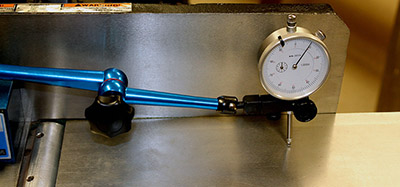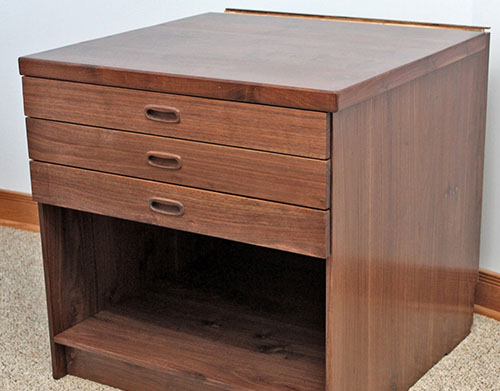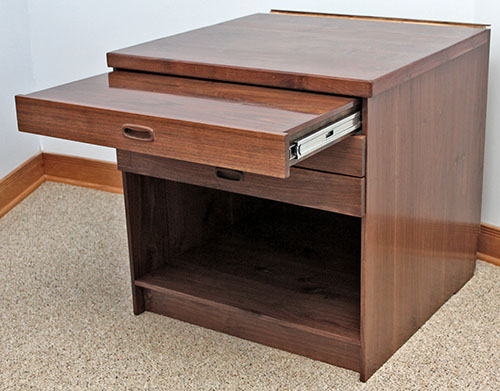Project: Mike's Desk
Ever since we moved in in January 2011, Mike has been using a 57" table for a desk, and rummaging through cardboard cartons to find office supplies.
He needs a desk, so we are building one in the shop. The desk will be 10 feet long, and will be bolted to the wall along the rear. The top will comprise three sections so we aren't faced with trying to do fine woodworking on 10' boards. A cabinet beneath the right end will have a pull-out shelf for holding papers when we both need to be at the desk, and two drawers for supplies.
This is the overall desk plan showing the lumber needed for the components.

March 16, 2013 – Getting started
We bought 75 board feet of walnut lumber locally and, after letting it acclimate to our home environment for several weeks, we inventoried it and planned how to cut each board into the needed components. Even though the wood seller surfaced three sides of the rough-sawn lumber, the surfacing is not up to par, and the lumber needs additional work. We have our work cut out for us.

Working the Wood
Our rough-sawn walnut must be cut and milled to the final sizes required. Wide desk parts will be fabricated from edge-glued pieces, as shown on the plan. The boards we received are not exactly the sizes the plan calls for, so Louise inventoried them, then carefully figured which pieces could be cut from each board.
We follow these steps to transform rough-sawn boards into pieces for the desk:
-
Inspect a board to determine exactly how to cut the required pieces from it. We want to keep as much dark heartwood as possible, and minimize the lighter sapwood. Here is board "Q" on the plan, ready to be transformed into two 6" x 29" pieces for part of a cabinet side. Each side requires five such pieces.

-
Crosscut the board into the designated pieces, cutting each piece slightly longer than needed. Here, the long "Q" board above has been cut in half, and one piece is being cut to 29½" long, removing the irregular end. (We later salvaged the heartwood from the cutoff, in case we need a small piece later.)

-
Joint the seller-jointed edge to yield a truly smooth edge.
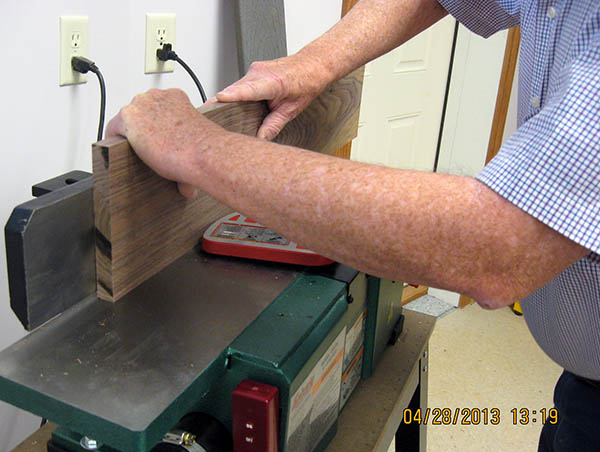
-
With the jointed edge against the table saw fence, rip each piece to be slightly wider than needed, discarding as much light sapwood as possible.

-
Edge-joint each piece until the desired width is reached.
Many desk parts are 27" to 30" wide, so we will fabricate them by edge-gluing narrower boards together. Edge-gluing requires all pieces to be exactly the same thickness. But sometimes, as this photo shows, a rough-sawn board might be warped and/or cupped.

Planing will remove these defects, but such a piece will be thinner than pieces made from straight boards. We must finish all pieces for one part at the same time – the thinnest piece dictates the thickness of all the pieces. Here's how we do that:
-
Crosscut each piece to exactly the length needed. We cut to length first because this operation might leave "whiskers" on the end of a board, but they will be removed by subsequent planing.
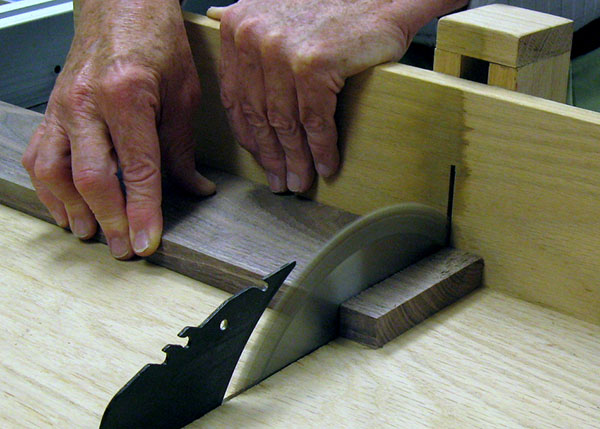
-
Plane one face of each piece to remove any warp or cupping, yielding one smooth flat surface that is the reference for the next planing operation. This is done on the jointer if the board is short enough to be fully supported by both tables.

-
We glue boards longer than 30" to a sled, and run that through the planer to flatten the first face.
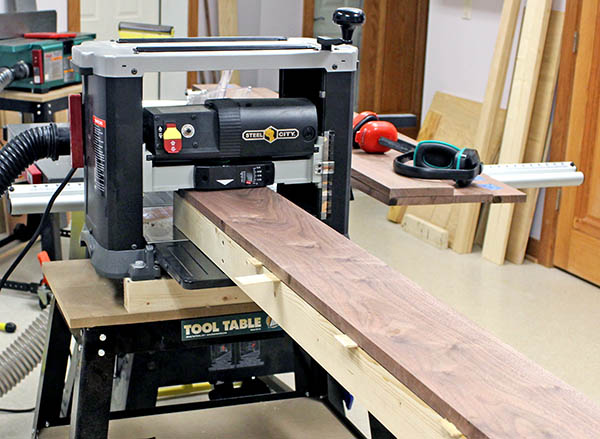
-
Run the unfinished face of each piece through the planer to remove any warp or bowing on that side, yielding a second smooth flat surface.
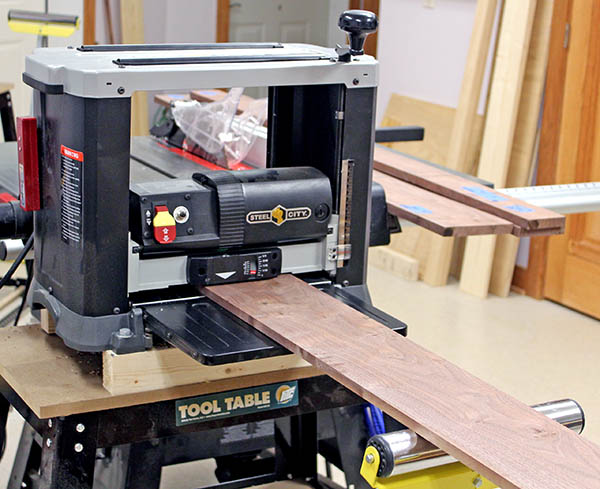
-
Measure the thickness of all pieces for one part, and set the planer to the thinnest in the batch. Plane all pieces in the batch to this thickness so they can be edge-glued. The pieces are now finished, and ready to be assembled into the complete part.
March 24, 2013 – Jointer Problems
Our first boards through a new Grizzly jointer started out with parallel edges, but ended up tapered. This shouldn't be. A jointer is supposed to remove a consistent amount of wood along the entire edge.
First we ripped the board on a table saw to make the edges parallel. We checked the width with a dial caliper at six locations along the length. Typically, the widths were equal to within 0.01". Then we jointed one edge and checked again. Now the leading end was 0.02" narrower, but the trailing end was unchanged – no wood was removed from the trailing end. Repeated passes through the jointer resulted in a seriously-tapered board. Reversing the feed direction resulted in a board with two narrow ends and a hump in the middle.
Clearly, something was wrong. Was it our technique or a defective jointer? The jointer is defective, or at least out of adjustment.
Mike used a machinist's dial indicator to discover that the infeed and outfeed tables are not in the same plane ("coplaner"). The outboard end of the infeed table is about 0.02" higher than the blade end. These photos show the measurement setup, with the indicator showing 0.010" midway along the infeed table (the magnetic holder wouldn't reach farther).
Apparently Grizzly agrees with this diagnosis. An email with these photos to tech support brought a prompt response with a return authorization. We'll have to package the jointer, but Grizzly is paying the freight.
This animation illustrates how the tilted infeed table causes the tapered boards. The tilt is exaggerated, but the principle is the same.
At the start, the board is pressed against the tilted infeed table, so wood is removed at an angle from a short portion of the leading end. As the board moves over the cutter head, it is supported by the outfeed table and by the elevated end of the infeed table, causing a tapered cut. Eventually, the board is pressed entirely against the outfeed table (standard jointing technique – no pressure on the infeed table), and the trailing end rises completely off the infeed table and away from the cutter head. No wood is removed past segment #5 above, so the board has a hump.

We proved this by measuring with a caliper, and also by placing the jointed edge on a flat cast iron saw table. The board rocked on the hump, and daylight could be seen under the high end.
The jointer is on its way back to Grizzly. We don't know if we'll get a new one or the same one correctly adjusted. Nor do we know how long we'll have to wait, but this project is on hold for a couple of weeks, at least.
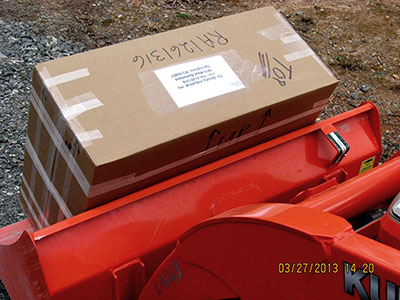
In the meantime, Mike has been reading an excellent book, Understanding Wood Finishing (highly recommended), and experimenting with various techniques. The best he's found so far is:
-
Using artist's arcylic paint, tint water-based grain filler to match the color of our walnut wood. Even though we bought "brown" (vs. "natural") filler, the color was far too light, so the filled grain was colored tan.
-
Fill the wood pores with the grain filler by spraeding it with a putty knife.
-
When dry, sand with 230-grit sandpaper. This removes all filler from the wood surface, leaving the grain pores filled (hopefully) to the same level.
-
Apply a second coat of grain filler, and sand again when dry. First tests showed that not all grain pores were completely filled with one coat.
-
Apply a coat of polyurethane wiping varnish.
-
When the varnish is thoroughly dry, rub with 000 steel wool.
-
Apply a second coat of wiping varnish.
-
When the varnish is thoroughly dry, rub again with 000 and finally with 0000 steel wool. This produces a semi-matte sheen that is somewhat shiny, but not glossy.
This photo shows the result of the procedure. It looks good and is very smooth, but some open grain remains – noticeable to the touch and visible in reflected light. The open grain is not apparent in this photo, since the filler is colored dark-brown, and this shot is in direct, not reflected, light. We will continue experimenting.

April 13, 2013 – Jointer alignment
We received a replacement jointer a week ago, but its tables were as poorly aligned as the one we sent back. Rather than fool around swapping jointers again, we decided to take a shot at aligning it ourselves – something we probably should have done with the first one.
To perform the alignment, we ordered a 24" precision straightedge. This arrived yesterday, so today we made the adjustments. This photo shows the straightedge and feeler gauges, plus a precision level that we used for preliminary adjustments.
It looks like our work paid off. There is no sign of taper after edge-jointing our test board. We will proceed carefully, since we're not completely sure of our technique. At least the initial result looks promising.

April 20, 2013 – Planer alignment
After aligning the jointer, it occurred to us to check the planer as well. It's a good thing we did! The infeed and outfeed tables were 0.015" higher than the center table. We used our new precision straightedge and made the necessary adjustments to secure both tables at the correct height.
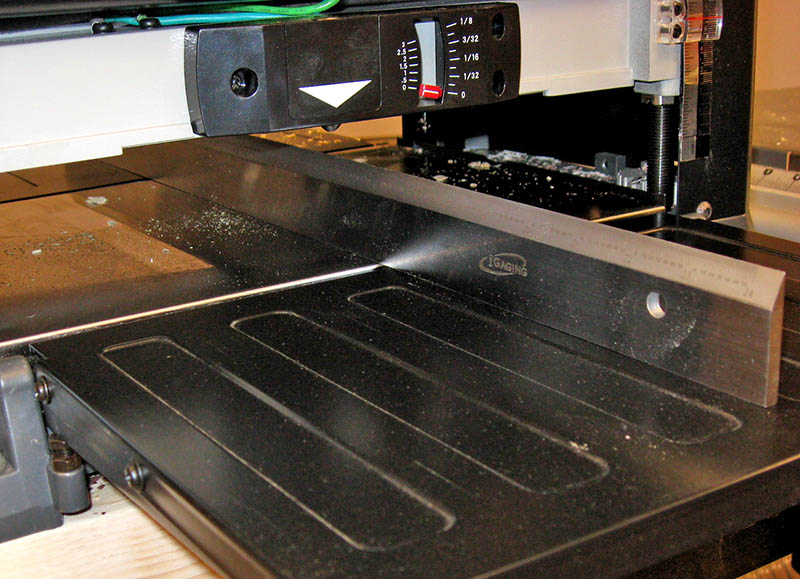
April 28, 2013 – Back to work
With the jointer and planer adjusted, we finally got to work cutting the rough-sawn lumber into pieces for the desk. After working for several hours yesterday and again today, we are about 40% of the way through cutting pieces to width and approximate length, and jointing both edges. This photo shows the results of our work. When we have all pieces to this state, we'll proceed with the planing operations (steps 6-9 above
).

April 29, 2013 – Cutting boards
We cut the remaining pieces for everything but the desktop. Louise referred to her lumber inventory, and marked the boards for cutting. Mike crosscut them on the table saw, then Louise jointed one edge of each piece, and gave them back to Mike. After careful inspection to determine where the good wood was located, Louise marked each piece, and Mike made the first rip cut. (On some pieces, one rip yields the correct width, but other pieces need two rips to remove sapwood or avoid splits, so it pays to plan ahead.)
Oh my! We had one cutoff that looked like it could be used for a spare piece. But during the first rip cut, the saw blade stalled on some tight grain. But the motor did not stall, and proceeded to melt the drive belt!
Fortunately, a Porter-Cable dealer has belts, so Mike ordered three, which should arrive in two or three days.
Here is today's batch of pieces after the first rip cut. Once we repair the table saw, we'll rip and joint them to width, and add them to our stock. The five long boards on the bottom are for the desktop, which will be made in three pieces. We'll begin working those boards when we're finished with the shorter pieces.
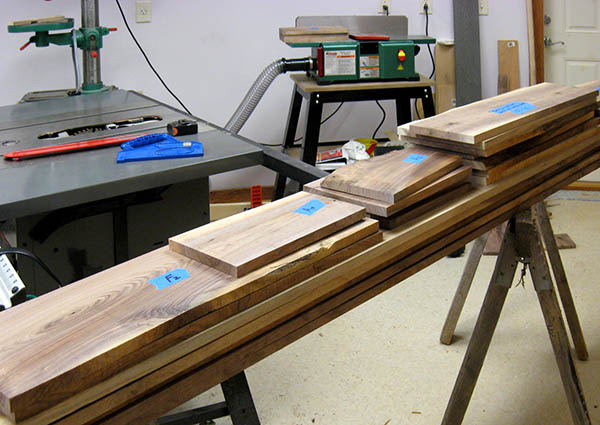
May 2, 2013 – Saw repair
The replacement belts for the table saw arrived in today's mail, so we spent an hour in the evening cleaning melted rubber from the pulley grooves, then installed one of the belts and reassembled the saw. We expect to resume cutting wood in several days, after taking the weekened to celebrate our younger daughter's college graduation.
May 11, 2013 – Cutting boards again
Our "several days" turned into more than a week, but today we got back to work. We finished cutting all of the pieces needed for the cabinet, drawers, and hutch. We jointed one edge of each piece, ripped them to width, jointed the other edge, and crosscut them to the exact length.
The only rough-cut lumber remaining is for the three-piece desktop.
Here is our stock of pieces ready for the next step – planing flat on both sides.
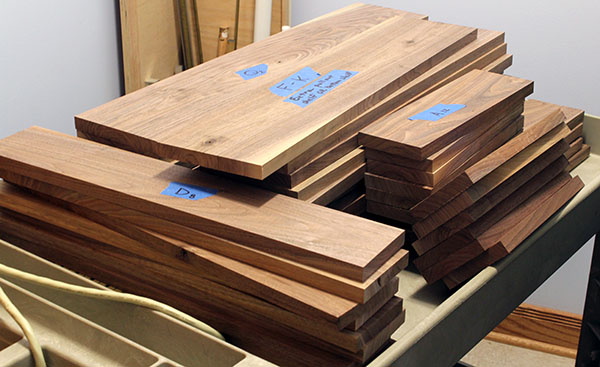
May 12, 2013 – First desk-top boards
Today's accomplishment was cutting the first of the five remaining long boards into three pieces for the first row on the 60" center desktop and the two shorter adjoining top sections (see the plan).
Here are today's three boards.

May 27, 2013 – Desk-top boards
We spent the past two weeks cutting desktop boards to width and approximate length. This is a time-consuming process because it is difficult to get a truly straight edge when jointing the 60" pieces for the center section.
The problem is, these boards are too long for our jointer. Even when supporting the overhanging ends on rollers, the board tends to follow any bow or belly along the edge. Mike clamped a straightedge to a board, then used a router with a flush-cut edge-trimming bit to straighten the edge. This worked fairly well, but still required some manual cleanup with a plane and sanding block.
At the end of today, we've cut four of the five long boards into sets of three pieces for the desktop. Only one long board remains.
May 31, 2013 – Board-cutting complete
We cut the final long rough-cut board into three pieces for part of the desktop, plus some narrow strips for desk nosing. All of the rough-cut lumber has been ripped to width, edge-jointed, and cut to length. The next step is to plane one surface flat on all boards, using the jointer, then plane the opposite surface flat using the planer. When using the planer, we must be sure to work all boards for each desk component using exactly the same thickness setting on the planer, so that they will have an even surface when edge-glued together.
Here are the boards for the three sections of the desktop, with the nosing pieces along the front of the workbench.

June 2, 2013 – Planing sled
Once again we find that the tables on our jointer are too short to accurately plane one surface flat on boards longer than about 28". Mike did some research online (the Internet is wonderful!) and came across the idea of making a "sled" to hold the board as it travels through the planer.
This is Mike's sled, made from pine boards, and run through the planer to create flat top and bottom edges.
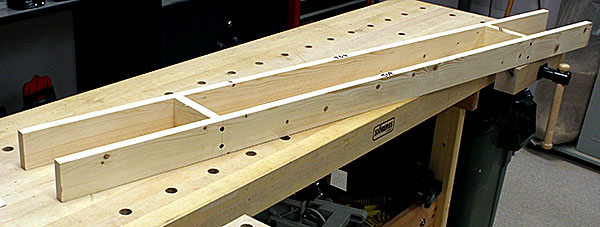
June 4, 2013 – Planing the boards
With the planing sled built, we began the process of flattening the boards. These photos show thow we process each long board, and shorter boards if they are severely warped.
A walnut board is placed on top of the sled and shimmed until it doesn't rock, then glued to the sled using tiny dabs of Gorilla Glue.
When the glue is dry, the sled and board together are sent through the planer several times to remove humps and warps. Once the board's surface is level, the glue bonds are cut with a putty knife (Gorilla Glue foams, so it is easy to slice).
Then the board is removed from the sled, flipped over, and sent through the planer again. The flat surface now on the bottom is the reference for flattening the opposite surface.
Planing this second surface also removes residue left from being glued to the sled. In the final step, we send the sled itself through the planer to remove glue residue and provide a fresh flat surface for the next walnut board.
Glue a board to the sled
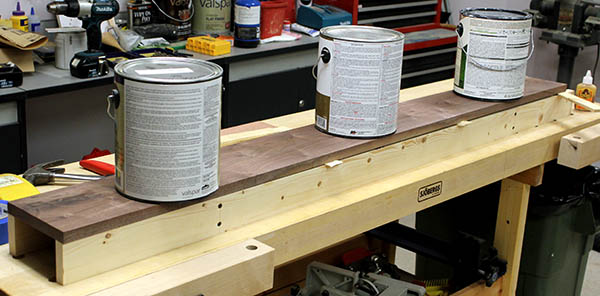
Plane the top of the board on the sled

Remove the board from the sled, flip it over, plane the opposite surface

Our first two good boards, four sides surfaced, 62" long

June 16, 2013 – Planing more long boards
Yesterday and today we planed two more of the 62" boards for the desktop on the planing sled. Four long boards are finished, and only two more remain. After we finish them, we can plane the short boards on the jointer and planer without using the sled.
June 20, 2013 – Cable tray covers
The desk will have a tray along the rear to hold computer cables, with thin walnut boards covering it. We used the bandsaw to "resaw" a ½"-thick board in half to make two ¼" boards.
Resawing means cutting a board through its thickness to make thinner boards, instead of cutting it to length (crosscut) or width (rip). When resawing, the board is fed through the bandsaw on edge. With this technique, multiple thin boards can be cut from one piece of wood. Here the blade is cutting a ¼" slice from a 5/8" board. The yellow featherboard presses the wood tightly against the fence to ensure a straight and even cut.
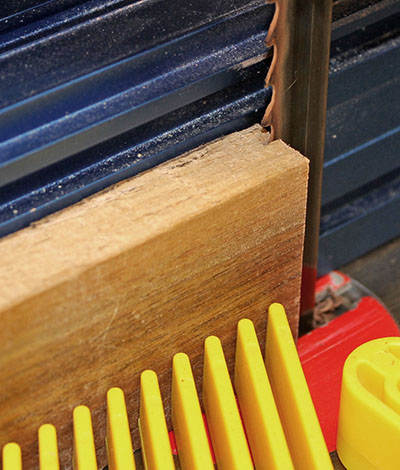
Planing reduced the tray cover boards to 3/16" thick. Here they are, ready for 1½" holes to be bored in them, then sanded and finished. We will set these 5-foot pieces aside until the desk is built.

July 2, 2013 – Planing desktop boards
After 12 days off, we got back to planing boards for the desktop. The five long center-section boards are done, so we planed the 10 short boards that will abut each end of the center section. Being only about 30" long, we could use the jointer to flatten one face, then run them through the planer to flatten the opposite face.
All of the desktop boards are planed, although not to their final thickness. Today's 10 boards are shown in front of the five long center-section boards. We store all planed boards on the floor to keep them flat.

Mike used the jointer to plane flat one surface on 32 "short" boards. Boards 30" or shorter are supported by both tables on our jointer, so it's fairly easy to eyeball any warp or cup, then feed a board through the jointer to flatten that surface.
Here are 22 of today's boards. Only a dozen 12" pieces remain to be planed on the jointer. After that, all boards must be run through the planer for final thickness-planing.

July 4, 2013 – Hutch side shelves
Mike planed the second surface flat on the dozen 4"x12" boards for the six hutch side shelves. Then we measured the thinnest board and planed all of them to this thickness. Finally, we edge-glued pairs of boards together to make six 8" shelves (four shown clamped in this photo).

July 5, 2013 – Hutch center shelves
Mike continued yesterday's work, and planed the second surface on the four 4"x18" boards for the two hutch center shelves. As before, he planed all four of them to the thickness of the thinnest bord, then edge-glued pairs of boards together to make two 8" shelves.
When the glue has cured, we will plane these two center shelves and yesterday's six side shelves to a final thickness of ½", preparing them to be installed in ½" dados (slots) cut into the hutch sides.
July 6, 2013 – Cabinet shelves
The cabinet on the right side of the desk will have two drawers plus a pull-out shelf for guests, and a lower shelf to hold reams of printer paper. Each shelf consists of five 6" x 28" edge-glued boards.
The ten boards were planed flat on one face several days ago, so today we planed the opposite face to make them all the same thickness. Each shelf will be 30" wide, which is too wide for our planer, so we must glue pairs of boards together, then run each pair through the planer to reach the final thickness. Once all the boards are planed, we will glue sections together, and remove excess glue by scraping and sanding.
Here 10 boards are stacked in the foreground, while two others are being glued in the pipe clamps.

July 7, 2013 – Hutch and cabinet sides
Gluing pairs of boards together for cabinet shelves takes time because we allow at least six hours for the glue to dry. In the meantime, today we planed boards for the hutch and cabinet sides. The four hutch sides are made of pairs of 4"x22" boards. We planed these eight boards to their final thickness, and they are ready to edge-glue when the pipe clamps become available.
The cabinet sides are similar to the cabinet shelves, each comprising five 6"x29" boards. We planed these 10 boards close to their final thickness so we can edge-glue pairs of them, similar to the shelves. Then we will plane the boards to their final thickness, and glue them into the full-width sides.
July 10, 2013 – Hutch sides
Yesterday we paired boards for the hutch sides and began edge-gluing them. We can glue only two pairs per day because we allow at least six hours for the glue to cure. Today Mike glued the final two pairs, so tomorrow they will be ready for final planing.
July 11, 2013 – Needed supplies
Excellent! Today we received a ½" router bit that we've waiting for. This will be used to rout slots for shelves in the hutch and cabinet sides. We can't plane these shelves to their final thickness until we know exactly how wide the slots will be. Tomorrow we will rout a test slot on a scrap of walnut, and measure it.
In the same package were two containers of wood filler, one colored dark and one light. Now we can fill any voids in boards before planing them to the final thickness.
July 13, 2013 – Planer adjustment
Yesterday Mike cut a test groove for shelves in a scrap of walnut, using the new ½" router bit. He measured the slot width (0.501") and planed another scrap to just a tad thinner than this. We plan to finish the shelves before assembling them into the slots, so Mike started the finishing process on the "shelf" scrap. He will check the final thickness when the finish is dry.
We noticed that boards planed recently have a shallow ridge running the entire length. This indicates a problem with the planer's cutter head. Our planer has a helical cutter head with 26 small blades, instead of two or three blades that are the entire 13" width.
We dug into the planer and discovered one blade's edge was slightly deformed and dull. Perhaps it hit a knot. We rotated this blade to its second cutting edge, but the ridge still showed up, albeit with a slightly different shape. We decided to remove and rotate the remaining 25 blades, cleaning their mounting platforms and alignment stops to remove accumulated dust. After this procedure, the planer again produces smooth boards.
July 19, 2013 – Planing progress
Sadly, the new edges on the planer blades (above) didn't last very long. After a couple of boards went through with good results, the ridges reappeared. Mike concluded that the tool-steel blades couldn't handle beads of dried wood glue where boards were edge-glued.
We ordered 30 carbide blades, and today we replaced the original blades with 26 of these. When we removed the original blades, we found that two of them were severely blunted. Since these were in the area of the glue bead on wide boards, it appears that the glue did indeed ruin the blades.
With the new blades installed, planed boards came out nice and smooth, with no sign of the ridge. in this photo, four edge-glued hutch sides on the left are ready to be finished and have grooves cut for shelves. The four pairs of edge-glued boards on the right are for cabinet shelves. These will be edge-glued with the two single boards angled on top of the stack to create two shelves approximately 29" wide. (The blue tape indicates small areas of wood filler that must be sanded.)
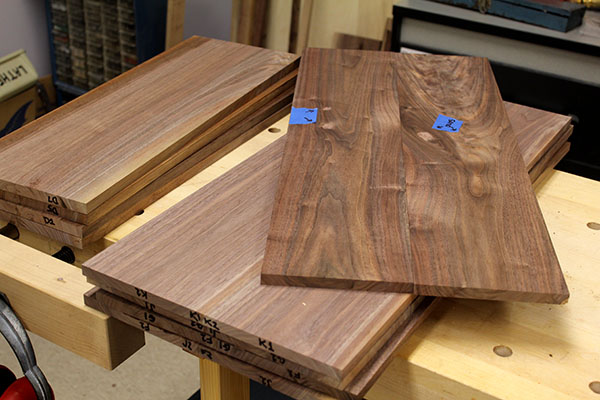
July 20, 2013 – Initial finishing
Mike applied grain filler to both sides of two hutch sides. When dry, he sanded the boards with 220-grit aluminum oxide sandpaper to remove the excess filler and expose the bare walnut.
This is the first of several finishing steps. After the grain pores are filled, we will apply several coats of polyurethane varnish, sanding between each. We're finishing the pieces prior to assembly to void sanding in tight corners.
July 26, 2013 – Finishing hutch shelves
Mike has spent several days applying grain filler to three hutch shelves, then sanding them emooth and applying varnish as the initial finish coat. sanding the grain filler flush with the wood surface is a slow and tedius process, so Mike tried using a random-orbit power sander. This produced a huge cloud or dust, so he reduced the tool's speed and mounted the sndpaper disk so the holes were not aligned with the holes in the tool. This prevents the tool from vacuuming the dust and clogging the filter. All of the dust remains on the wood, and we brush it off later.
We have no photos of this work, but the shelves are turning out nicely.
August 1, 2013 – Finishing hutch shelves
Several days ago we applied grain filler to the remaining hutch shelves, and today we sanded it smooth to the wood surface. We wiped the boards with solvent, then wiped on a coat of thin polyurethane varnish to provide a base coat for subsequent coats of regular varnish. Here are some of the boards drying on the planing sled.

August 16, 2013 – Finishing hutch parts
We took some time off, but in recent days we have been finishing sides and shelves for the hutch. After today's work, all parts have at least coats of wiping varnish on both sides, and most of them have the final finish coat as well. The shelves have a finish coat on top, and a close-to-finish coat on the bottom. The sides need a finish coat on both surfaces, so tomorrow we'll apply one more coat where needed.
Here are most of the boards we did today, waiting for the varnish to dry.
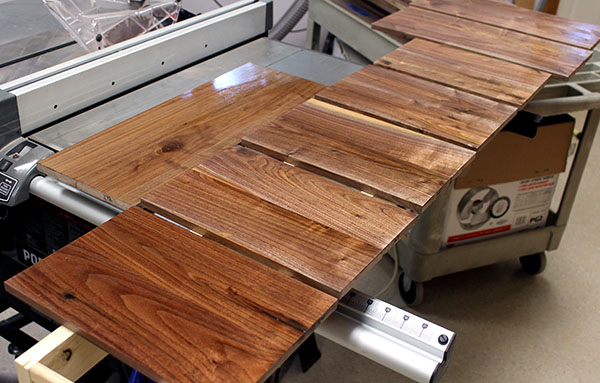
August 27, 2013 – Hutch shelf routing
The hutch boards are finally finished with three coats of wiping varnish rubbed with #0000 steel wool to a satin finish. Today we routed slots in the sides for shelves.
To ensure accuracy, we clamped all four hutch sides to the workbench, then clamped a straightedge over them. One pass with the router yielded a perfect ½" slot in all four sides.
Next step: dry-fit the hutch and measure for the backing board, then cut and finish that piece. After that, we can build the hutch.

August 28, 2013 – Hutch dry-fit
Mike dry-fitted the hutch on the workbench, then measured and cut the backer board. Last, he stained the rear of the board to check for a good color match with the real walnut hutch.
Later. . . . The color didn't match well, so we chose a darker walnut stain, and Mike stained the front of the backer board.
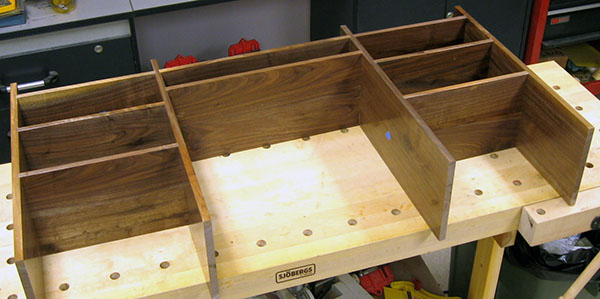
August 29, 2013 – Hutch assembly
We glued the hutch together in two steps. First, we assembled and glued the left and right end sections and clamped them using vises at the ends of the workbench and pipe clamps on top.

When the glued ends were dry, we applied glue in the slots for the center shelves, then assembled them between the end sections. We measured carefully to ensure everything was square, then tightened the bench vises and the one pipe clamp.
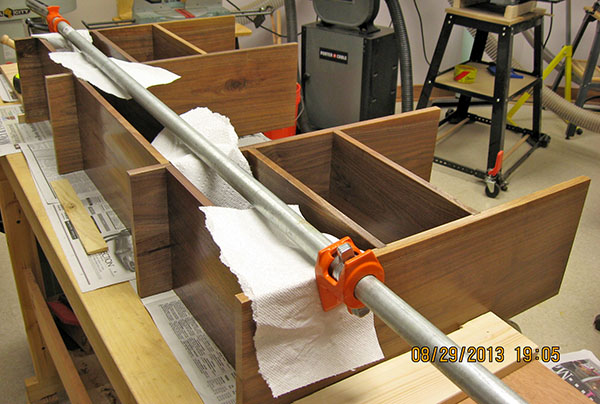
August 31, 2013 – Hutch complete!
Today we glued and pinned the backer board to the hutch.
One remaining job is to fashion four trim pieces to cap the top end-grain on the side pieces. These were not planned, but they'll make the hutch look more finished. It's a minor task, involving jointing one edge on a scrap board, then slicing-off a thin strip. Repeat four times, cut the strips to length, sand smooth, finish, and glue them on.

September 1, 2013 – Hutch caps
Mike made the end-grain caps for the hutch, and they turned out as well as hoped.
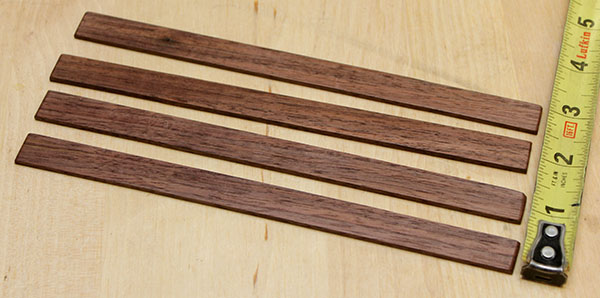
September 5, 2013 – Gluing cabinet shelves
Two days ago, we edge-glued the first of two shelves for the cabinet, and today we glued the second. We use pipe clamps across the boards, and small clamps on the ends of joints to ensure that the surfaces are flush. This shelf consists of two 12"-wide boards that were edge-glued back in July, plus a 6" center board.
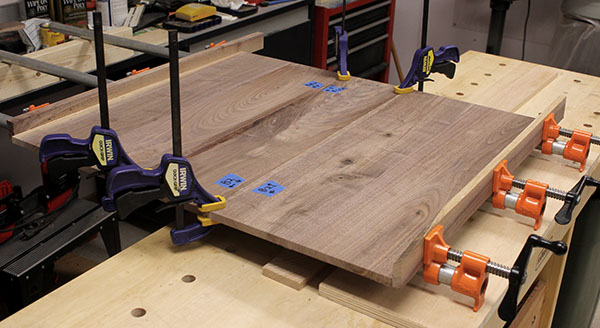
September 9, 2013 – Gluing cabinet sides
Today we planed to the same final thickness the 10 boards that will become the cabinet sides. Then we edge-glued two pairs of boards. Two pairs remain to be glued. The two sides will each comprise two pairs plus one individual board edge-glued together.
September 20, 2013 – Cabinet panels and drawer pulls
We have complete edge-glued panels for the cabinet sides, cabinet top, cabinet bottom shelf, and cabinet pull-out shelf. We spent a couple of hours today planning the cabinet and figuring dimensions of the shelves and drawers.
Later, Mike made a template from ¾" plywood to guide the router when cutting recesses for walnut pulls in the drawer fronts. This photo shows a pull resting in a test hole, with the template and router behind.

September 21, 2013 – Cabinet work
We got a lot done in two hours today. We measured and routed holes for the pulls in the front boards for the drawer and the pull-out shelf. This photo shows the fronts with the empty holes, and the pulls test-fit into the holes. (This is an oblique shot; all holes and all pulls are actually the same size.)

With the drawer pulls under control, we cut the pull-out shelf to its final size. Then we cut and stained two pine rails that will hold the full-suspension slides for the pull-out shelf. After that, we filled about 18 blemishes and rough grain in the desktop that will fasten to the cabinet.
September 23, 2013 – Struggling with wood filler
It's hard to believe that this project has been halted by something as trivial as wood filler. The walnut has various blemishes, ranging from tear-out from machining to rough end-grain in knots and elsewhere. Our plan was to fill these blemishes with a highly-recommended (by the Woodcraft store personnel) filler. We bought a sample size of "natural" color, but it was far too light. So we bought full-size containers of "walnut" (dark brown) and "ebony" (pure black).
The "walnut" spread on nicely, and matched the wood fairly well, but when we sanded the dried filler, it turned the same color as the "natural!" We tried mixing "ebony" with the "walnut" in various proportions, but that also lightened drastically when sanded. The pure "ebony" turned medium-gray when sanded.
This photo illustrates the problem. The knot has rough end-grain, so we spread a layer of filler over it, and let it dry. We started with "walnut" and "ebony" filler mixed about 60/40 to darken it but still keep the brown tint. When we applied the filler, it was very dark brown – darker than the portion of the knot at the 4:00 o'clock position. Look at how light it became during sanding! This is the color of the "natural" filler.
We can't use this filler, so tomorrow we'll call Woodcraft to ask for advice and see if they'll give us a partial refund. Maybe there is a different brand that will retain its color.
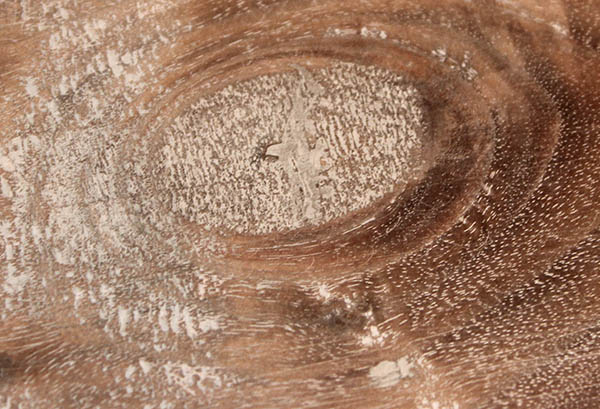
September 27, 2013 – Wood filler solution?
Three days ago we visited the Woodcraft store with the cabinet desktop panel, to show the problems we are having with wood filler lightening after sanding. One of the experts there claimed that the filler will return to its original color when dampened with mineral spirits or shellac. He demonstrated this on the bottom side of the panel and, sure enough, it turned dark and remained dark after the shellac dried. He also demonstrated two types of stain that can be used to darken the filler (and the wood) further, to make color variations less noticeable and still provide a rich finish. We bought a bag of dewaxed shellac chips and the two stains. Hopefully these will solve our problems.
This "before" photo shows the cabinet desktop panel after the wood filler was sanded. The light areas are the wood filler. I will post photos of the same piece after we do final sanding and apply the shellac and stain.
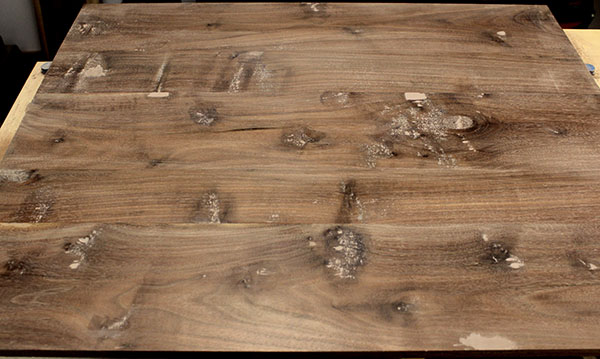
September 28, 2013 – So far, so good
Mike sanded the cabinet desktop panel, then wiped it with a paper towel dampened with mineral spirits. When this dried, he wiped on a thin coat of shellac. This photo shows the result – the light wood filler has darkened, and the filled areas are not so noticeable. Our next decision is whether to apply stain to darken everything slightly and make it blend together more.
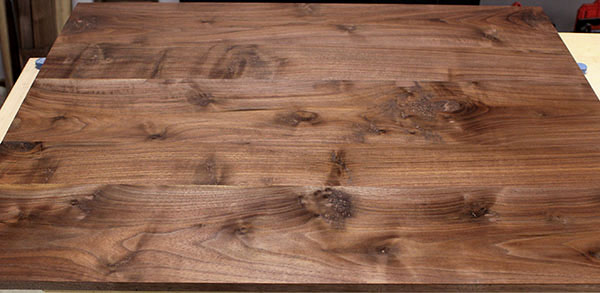
The shellac raised the grain in several areas on the cabinet desktop, so Mike used 400-grit sandpaper in a power sander to smooth it. Fortunately, sanding didn't lighten the wood filler. Next he wiped-on a coat of "American Walnut" stain. This darkened the panel slightly, and helped visually blend the wood filler with the surrounding wood.
This photo shows the stained panel. In particular notice now the two light bands of sapwood on the left side of the panel above are less noticeable after staining. This required some careful wiping of stain only in the light areas, then more careful wiping to remove excess and blend the edges.

October 2, 2013 – Desktop nosings
With the cabinet desktop panel under control, Mike worked on nosings for all of the desktop panels' edges. The front edge and visible ends of the panels will have a ¾"-thick nosing 1½" tall, with rounded top and bottom edges. The ends that butt against adjacent panels will have 1/8"-thick nosings just a bit taller than the panel thickness (they'll extend below the panel, not project above it).
This photo shows three visible nosings with ¼" radius rounded edges, plus three hidden "butt" nosings. Only the top edge of the hidden nosings will be visible. All nosings are longer than needed, so any defects on the ends will be cut off.

October 6, 2013 – Pull-out shelf
Mike has been working on the pull-out shelf over the past several days. He cut and planed two 1/8"-thick by ½"-tall nosings to cover the end grain on the shelf sides. He drilled holes to attach metal drawer slides to two ¾" pine rails on the shelf bottom, one on each side, then he glued them on. Finally, he glued the previously cut front board to the shelf assembly. After final sanding and wiping with mineral spirits, Mike wiped-on a coat of shellac. When that dried, he applied a medium-brown stain over the whole shelf to darken and blend the light sapwood areas. When that was dry, he applied a darker stain to sapwood that was still too light.
This is the shelf with shellac, but before staining. Notice the light sapwood bands, especially at the center-left. (The right half of the shelf is brighter due to overhead shop light reflections, so that sapwood appears lighter than it really is.)

With a different camera angle to minimize reflections, here is the shelf after staining. The sapwood now is much less noticeable. The remaining task is to apply several coats of wiping varnish for the final finish.
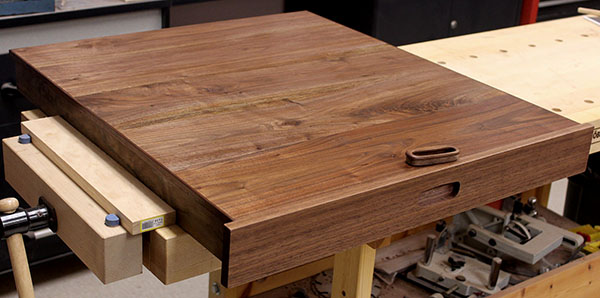
October 12, 2013 – The cabinet desktop looks great!
Mike glued and sanded the nosings on the front and right edges, followed by a 1/8"-thick nosing on the left side, where this piece will adjoin the main desktop. This thin nosing is shown in the left detail photo. Mike mitered and glued two pieces into an "L" shape, so end grain cannot be seen. The grain runs along the panel edge, and turns downward at the front nosing.
The main photo shows the complete desktop. The nosing gives the panel a substantial look, and disguises that it is only ½" thick.

October 14, 2013 – First drawer built
Yesterday Mike cut the sides and bottom for the two drawers in the cabinet. The drawer fronts are walnut, but the sides are made of select pine. The bottom is 5mm luan plywood. The rear board is glued into rabbets cut into the ends of the side pieces. The front board is glued to the butt-end of each side, and the these end-grain joints are reinforced with a small strip of wood glued inside each corner. The bottom panel is captured by a groove in all four sides, and is not glued.
No screws are used in the drawer construction, since wood glue alone is strong enough for this light-duty application. The drawer sides and bottom are finished with a coat of varnish, and remain their natural color. The front is finished like all other walnut – shellac, stain, and several coats of wiping varnish.
Here is the complete 2' x 2' drawer with the front and sides for the second drawer resting in it. The side board on top of the stack shows the bottom groove and the rabbet for the rear board.

October 15, 2013 – Both drawers built
Mike assembled the second drawer and applied shellac and stain to the front. All that remains is to varnsh the walnut, add the pulls, and attach the full-extension slides.
October 18, 2013 – Varnishing the drawers
Mike made good progress over the past few days varnishing the pull-out shelf and the drawer fronts. So far, he has applied three coats of wiping varnish to the shelf top and front, and two coats to the drawer fronts. He smooths the dry varnish by rubbing with 0000 steel wool. Three coats of the thin varnish probably are enough, but he might go to four.
October 19, 2013 – Drawers complete
Mike applied the final coat of varnish to the pull-out shelf and drawers, then moothed it to a matte finish with steel wool. He glued the pulls to all three fronts, and these components are complete, and ready for their metal slides.
Next up: Build the cabinet and install the shelf and drawers.

October 24, 2013 – Cable tray parts
The desk will have a tray along its rear edge to hold computer cables and power cords. After considerable measuring and planning, Mike produced two drawings, and cut the pine for the cable trays on all three desk sections.
Our router and router table aren't up to the task of cutting precise rabbets, so Louise came up with the excellent idea of gluing a thin strip of wood to the tray sides to create the ledge needed to hold the walnut tray cover. Here are the tray parts after planing to the fairly precise dimensions needed for the cover to rest flush with the desktop. The thin boards will be glued to the sides to create the ledges.
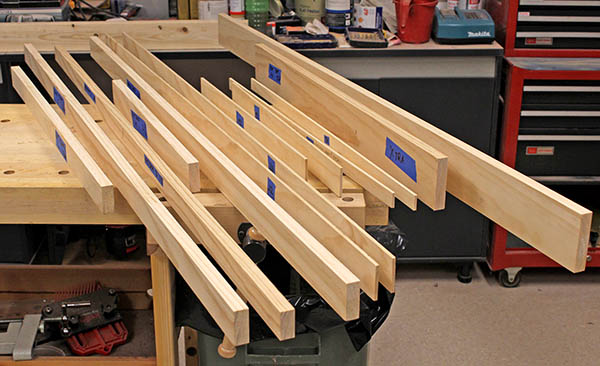
October 26, 2013 – Cable trays
Yesterday Mike discovered that he hadn't planed several cable tray parts to the right thickness, so he corrected that. Today he glued the parts for the desktop extension (left end) cable tray, and together we both glued the parts for the main section (clamped in photo).

October 28, 2013 – Cable trays finished
With the cable trays fabricated, Mike cut and planed thin ½"-wide walnut trim strips for the rear side.
This photo shows how the walnut cover will rest on the tray ledges between the desktop and the trim strip. The front of the cable trays will be glued to the underside of their respective desktops. The desktop, cover, and trim strip all are in the same plane.
The shallow tray in ghe center is for the cabinet, where the pull-out shelf must slide beneath it. All cable trays are longer than needed, so the excess wood overhanging the ends will be gone once the desktop sections are complete and the trays are cut to length.

November 5, 2013 – Cabinet asembly setup
Mike began preparing the cabinet sides for assembly. A few days ago he routed a slot in each side panel for the lower shelf. Unfortunately, the guide board for the router shifted partway through the process, so the slot wavered. To recover, we moved the guide upward about ¼" and routed the slot wider, and straight on top. The shelf will be upported by aluminum angle rails below, forcing it upward against the straight top of the slot.
This photo shows a ½"-thick stand-in for the shelf, an angle rail, and matching holes in the cabinet side. It is vital that screw holes do not break through the good side of the wood, so Mike machined a Delrin stop for the drill bit (foreground). The set screw holds the stop in place on the bit, and the bit is inserted into the drill chuck until the stop touches the jaws. This provides a positive depth limit – the drill can't possibly go any deeper.
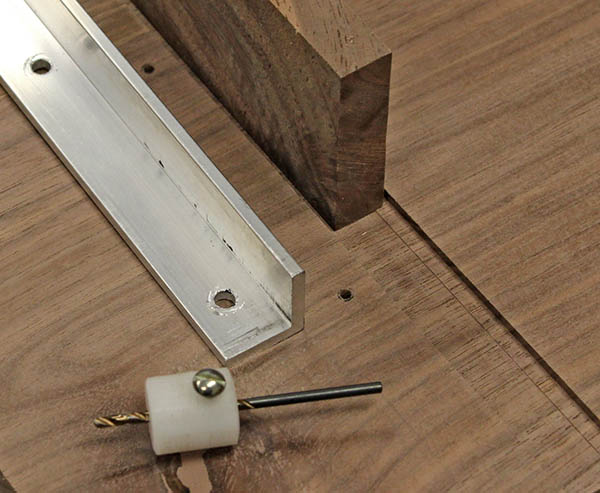
November 7, 2013 – Cabinet asembly setup
Yesterday we cut the cabinet side panels and the bottom shelf to their final dimensions, and cut off half an inch of the pull-out shelf so it will fit inside the cabinet. The next step is to drill mounting holes for the drawer slides.
Mike used Adobe Illustrator to create a template showing the pull-out shelf and drawers relative to the cabinet desktop. We used this to verify that the planned 1/8" space between drawer fronts is really what we want. The template also shows the centerline where holes for the drawer slides are already drilled in the shelf and drawer sides.
He printed three copies of the tamplate, and taped them to the cabinet sides, precisely aligned with the line representing the bottom of the desktop nosing. Then he transferred the drawer slide centerlines to the cabinet sides. Next he will lay the slides over the lines and mark the mounting holes, then drill with the limited-depth bit.
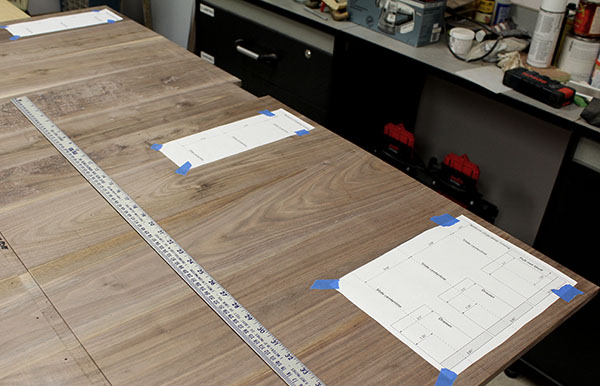
November 10, 2013 – Cabinet panel finishing
Yesterday Mike sanded the cabinet bottom shelf, and spread grain filler on the top surface. Today he scraped and sanded the excess filler off, leaving the wood pores filled flush with the surface. Later he applied a coat of shellac, sanded that smooth, and wiped on a coat of wiping varnish, one of three coats that will be applied.
The bottom shelf is in the foreground, and one of the cabinet sides is behind it, ready to have its edges masked, and grain filler applied. The sides need to have their grain filled on both surfaces, since both will be visible, and grain filler yields a smooth finish.

November 13, 2013 – Filling the grain
Mike applied one more coat of wiping varnish to the cabinet bottom shelf, then spread grain filler on the exterior faces of the cabinet sides.
Grain filler is a soupy mixture that is spread with a hard rubber blade, diagonally to the grain, to force the filler into the grain pores. When dry, the filler forms a tan chalky skin that must be removed to reveal the wood.
This photo shows one cabinet side with the filler scraped from the center portion, and the debris piled in the foreground. Once most of the filler is scraped off, the entire surface is hand-sanded with 240-grit sandpaper. This is a tedious process, because the filler leaves hazy patches that aren't visible until the dust is removed and the panel wiped clean. Any haze must be sanded until no tan dust is produced, indicating that no filler remains on the surface (in that spot). The proceess involves repeated sanding, wiping, and inspecting.
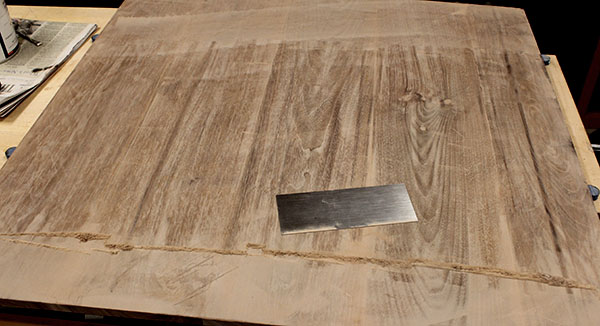
When done, the filler remaining in the pores is flush with the wood's surface, which then is nearly glass-smooth, ready to finish.
The photo below shows the dramatic difference in appearance between the smooth filled grain (right) and unfilled grain on the left. Both areas have two coats of wiping varnish.
For this shot, the camera was oriented to catch light reflected from the wood surface, so the grain pattern on the right is masked. Viewed with no reflection, the grain is clearly visible.

Final finishing involves:
-
Wipe with mineral spirits; allow to dry thoroughly.
-
Wipe-on shellac, which dries within minutes.
-
Sand with 400-grit sandpaper, because the shellac raises some grain.
-
Dry-wipe to remove sanding dust.
-
Wipe-on stain to subdue wood color variations; allow to dry thoroughly, usually 24 hours.
-
Apply three coats of wiping varnish, allowing 24 hours to dry. Sand with 800-grit sandpaper to remove any dust or bubbles. The final coat is not sanded, but is rubbed with 0000 steel wool if necessary to produce a matte finish.
November 21, 2013 – Cabinet hardware
Over the past several days, Mike made and installed cleats to hold the cabinet kick plate along the front, beneath the bottom shelf. Using cleats allows the kick plate to be attached from behind, eliminating all visible screws. The cleat is the light-colored block on the left corner of the side in the photo below.
Mike also milled the kick plate to its final size, filled the grain, and applied shellac and stain. It is ready for final finishing and attachment to the cabinet.
Today Mike installed the aluminum angle rails that will fasten the desktop and bottom shelf to the cabinet sides. He also screwed three drawer slides to each side. The cabinet is almost ready to assemble.
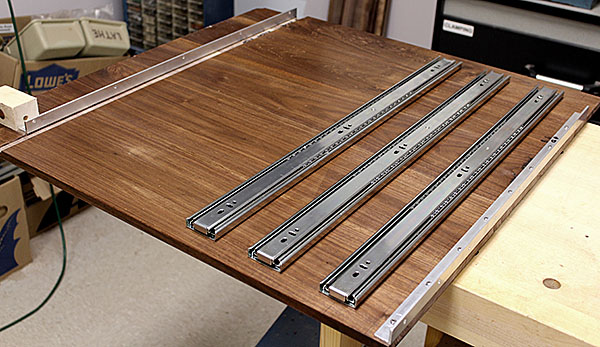
November 24, 2013 – Cabinet drawer slides installed
Oops! The drawer slide spacing turned out to be slightly off. Mike made a 1:1 scale drawing to transfer precise measurements to the wood. After several tries, he got it right. The spacing on the cabinet sides turned out to be okay, but the holes had to be re-drilled in the drawers. Mike installed slides on the cabinet sides, the two drawers, and the pull-out shelf (not shown in the photo below). The cabinet finally is ready to assemble, which probably will require both of us working together.
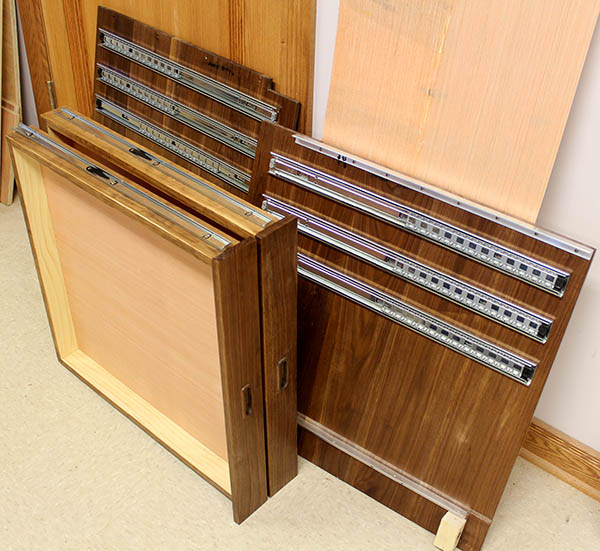
November 26, 2013 – Cabinet (mostly) assembled
Mike installed the remaining aluminum angle rails, then we assembled the bottom shelf to the two sides. We added a wood stick across the top to prevent the sides from spreading apart. Once the bottom shelf was secure, we turned the cabinet upright and added the drawers and pull-out shelf on their slides. After some minor adjustments to the front spacing, the cabinet looks pretty good, but a few more adjustments are needed.

November 30, 2013 – Detour! Bed Rails
Daughter Miranda's bed collapsed several weeks ago, and Mike finally took a break from building the desk to fix it. The frame rails are made of ¾" plywood, and two of the metal brackets that connect them to the headboard broke out of the rails. The plywood delaminated, and the brackets ripped out one side of the rail.
Mike and Miranda cut new ¾" oak boards to size, and machined 5/16" brass pins to hold the brackets in the ends of the boards. Then Miranda drilled blind holes for the pins.
The next day, Mike and Louise used the bandsaw to cut vertical slots in the ends of the 5"-tall oak rails. Later Mike pinned the brackets in place. He also used the same bandsaw fence setup to resaw one of the ¾" oak cutoffs into two 3/8"-thick planks, which he then planed to ¼" thick. He cut one plank into four 3" lengths, then used a belt sander to to bevel one end of each piece, and glued these to the outside of the rails to reinforce the wood outside the metal brackets.
Today Mike used a router to round-over the edges of the rails. Next he will fill the grain, sand, and spray-paint them black.
This photo shows the two new rails next to one of the broken original rails. Mike worked outdoors in 38°F temperature to eliminate router shavings and sanding dust in the shop. (He'll use a power sander to smooth the grain filler, which produces a lot of dust.)
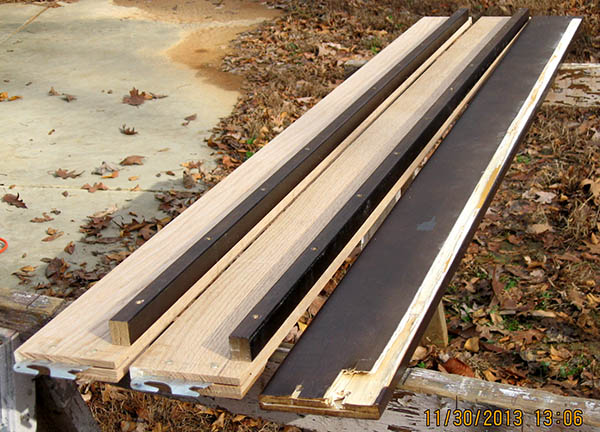
December 10, 2013 – Cabinet desktop refinish
When we assembled the cabinet a week ago, we discovered that the desktop was 1½" too wide. Sadly, the left edge already had a 1/8"-thick nosing applied, so cutting the desktop narrower put that nosing at risk.
We decided to try and salvage it. First we cut the desktop to the correct width on the table saw. Then we took the cutoff with the thin nosing to the bandssaw, and adjusted the fence to the nosing thickness. Amazingly, the bandsaw cut off the nosing precisely, and no further planing or sanding was needed.
Several days later (after Mike cut 5mm luan plywood for the cabinet back, and attached it), Mike glued the thin nosing onto the left edge of the cabinet desktop. This resulted in a slightly uneven edge, which had to be scraped and sanded flush.
Naturally, the scraping and sanding damaged the varnish in that area. Mike noticed that some of the sapwood grain was rough, so he took this opportunity to refinish the entire top. He scraped and sanded the panel, then applied grain filler to the sapwood areas. When this was dry, he scraped and sanded the wood smooth, applied shellac and stain, and spread three coats of wiping varnish. This work took four days, but the desktop now looks better than ever.
Here is the refinished cabinet desktop. All that remains to be done is to rub it with 0000 steel wool to subdue the shiny finish, and attach it to the cabinet.
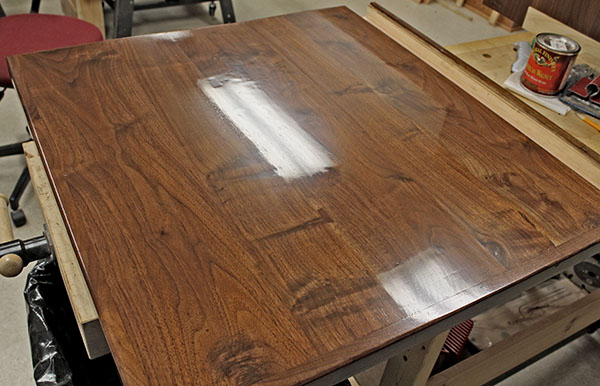
December 16, 2013 – Cabinet pullout shelf refinish
The refinished cabinet desktop turnout very nicely, so we decided to also refinish the pullout shelf, which had some aof the same open grain as the desktop. Mike used wood filler to patch a few knot holes and gouges that we missed the first time. Then he spread grain filler and, when dry, sanded it off. He followed this with a coat of shellac and stain. When the stain is dry tomorrow, he will apply several coats of wiping varnish.
Here is the pullout shelf with the top surface filled and sanded, ready for dusting and shellac. It's sobering to attack nicely finished wood with a scraper and 180-grit sandpaper, but we have confidence it will turn out fine, based on the desktop. The finished front of the shelf will not be refinished because it has the drawer pull glued in place.

Skipping ahead three days, here is the refinished shelf after the third coat of wiping varnish.

December 20, 2013 – Cabinet complete!
With the pullout shelf refinished and looking great, we put it on its slides, then moved the cabinet from the workbench into the hobby room to rest until the main desktops are finished. Here is the complete cabinet with all drawers closed, and with the shelf partially pulled out. (The odd-looking strip along the rear is the open cable tray, which ultimately will have a thin cover flush with the desktop.)
December 20, 2013 – What's left?
A friend asked how much was left to do before the desk is complete. The answer is, not much. This photo shows the remaining 10 pieces of walnut that will become the main desktop and the left extension. The single narrow board is one of two pieces for cable tray covers. Once the workbench is freed when we remove the cabinet, we will edge-glue these planks together, then smooth and finish them, and the desk construction will be complete. Following that, we'll need to install it in Mike's office, which will entail bolting it to the wall and fabricating one leg for the main-extension joint.

Updated
May 23, 2023












